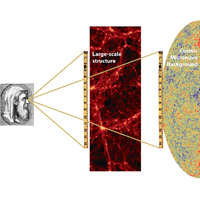What are baryonic acoustic oscillations?
Baryon acoustic oscillations (BAO) are a pattern of wrinkles in the density distribution of the clusters of galaxies spread across the Universe. They are a subtle but important effect because they provide an independent way to measure the expansion rate of the Universe and how that rate has changed throughout cosmic history.
 |
| Illustration of Baryonic Acoustic Oscillations. Credit: NASA, ESA, and R. Massey. |
The baryon acoustic oscillation are imprinted on matter in the early Universe. When the Universe was in its infancy, matter was spread out in an almost uniform sea of particles, and gravity was trying to alter this by pulling large pockets of matter together to form galaxies.
This was not an easy process because the matter heated up as gravity pulled it together. This created an outward pressure that pushed the matter apart again. As it expanded, however, it cooled and gravity started to pull it back together again. This interplay of gravity and pressure set up an oscillation that created the equivalent of sound waves. These spread outward in bubbles, carrying along some matter with them.
When the Universe reached the age of around 380 000 years, atoms formed for the first time. This allowed the matter to cool more efficiently, and gravity started to dominate. With little now to resist it, large scale structures started to form and imprinted on these structures were the bubbles of matter created by the acoustic waves. These bubbles are the wrinkles visible today as the baryon acoustic oscillations.
In addition to this, the cosmic microwave background radiation was also released as atoms formed for the first time. The temperature variations that ESA's Planck mission measured in that radiation are produced by the different densities of matter in the early Universe and on certain size scales can be directly relatable to the baryon acoustic oscillations.
Detecting the signature of the oscillations is so useful to cosmologists because the size of them is determined by the properties of the early Universe and its components: the normal (baryonic) matter, the dark matter and the dark energy. Thus, they can be used to constraint the properties of these components.
In addition, the way the BAO signature changes across cosmic time can be used to measure the expansion of the Universe and the way this evolves.
The BAO signature was detected for the first time in 2005. Two teams of astronomers working independently found the signal in their surveys of relatively nearby galaxies. The Sloan Digital Sky Survey in New Mexico, America, and the 2dF Galaxy Redshift Survey, in Australia, made the discovery.
These surveys showed that the size of the BAO signal in the modern Universe is approximately 150 million parsecs. This figure represents the sound horizon in the early Universe and is in good agreement with the figure predicted by analyses of the cosmic microwave background radiation. Now that the scale of the BAO has been clearly established, Euclid's job is to detect them across a large volume of the Universe.
Taken together, the weak gravitational lensing and the baryon acoustic oscillations provide different ways to measure similar things from the same volume of space. This provides essential cross-checks that will help eliminate systematic errors in either approach. By measuring the large scale structure of the Universe via such different physical properties, such as gravitational potential, density and expansion velocity, cosmologists can make stringent tests on different models of dark energy and even Einstein's General Relativity. This later is an essential test to make in case our understanding of the gravity does not quite describe the force's behaviour on its largest scales.
| Read more |
| 1: Mission science |
| 2: What is dark matter? |
| 3: What is dark energy? |
| 4: What is gravitational lensing? |
| 5: What are baryonic acoustic oscillations? |
| 6: Legacy science (beyond cosmology) |
